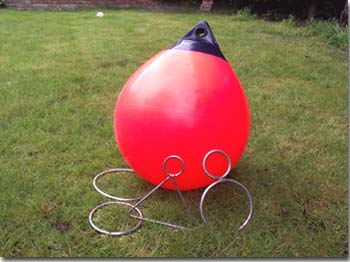ANCHORS and TIPS FOR ANCHORING

Chuck,
I have been giving some thought to anchoring, and the
recovery of the same. This week I met an old friend who keeps
a yacht in the Eastern Mediterranean, and he mentioned the
Alderney system of anchoring. I had never heard of this and
he explained it to me as best as he could. I then did a bit
of googling and came up with the attached piece.
I telephoned the Crayford Marine people, and they told
me that this method is ages old, and that they sell the bits
to set it up. I told them that I wanted to publish it, and
they said to go ahead.
As you will see, it would not be feasible
to use the method under sail, as it would not be possible to
get close enough to the wind; but using a motor makes it a very
useful way to remove a lot of the work from raising an anchor.
Anchor recovery
- Alderney Anchor Rig
By courtesy of Crayside Marine (Kent, UK)
The modern method of anchor recovery used by an ever-increasing
number of dinghies and charter boats is with the aid of a buoy.
The size of the buoy is selected to provide sufficient buoyancy
to float the anchor and chain and will probably be in the 20-24
inch diameter range. The buoy is fixed (usually by, splicing)
to a 3ft length of 10 - 12 mm rope and is then clipped to a large
diameter ring that slides on the anchor warp.
When the anchor is lowered, the warp is allowed to slide through
the ring, which is temporarily retained in the boat. When the
anchor reaches the seabed and the warp starts to pay out, the
buoy is clipped to the ring and dropped over the side. (note some
skippers prefer to put the buoy over the side before the anchor
touches the bottom) When sufficient warp is out, it is cleated
off and the buoy then slides on the warp via the ring. The buoy
will remain close to the bow of the boat by tide action and will
be out of view. It is preferable to have the buoy in view to indicate
clearly that the boat is at anchor so just prior to cleating off,
a stop can be attached onto the warp to stop the ring. By releasing
additional rope and then cleating off, the buoy will float a distance
from the boat.

Typical Alderney Set-Up
To recover the anchor, the boat is steered forward at an approximately
30-degree angle to the warp to provide a safety clearance for
the boat and warp. As the buoy clears the stern, the crew takes
the warp inside a stern cleat. (This step of the operation is
not always done but it is probably safer to do it.)
Under no circumstances secure to the stern cleat as this
is potentially dangerous, the anchor load MUST always be taken
on the bow.
By motoring uptide (or in the direction of the anchor if there
is no tide), the angle of pull releases the anchor and the warp
flows through the ring.
Eventually the chain passes through the ring leaving the anchor
and chain suspended by the ring and supported near the surface
by the buoy. The manoeuvre is completed by the crew pulling the
warp back into the boat, with just the weight of the floating
gear to contend with. The recovery of the gear can either be from
the bow or amidships, the latter is ideal for boats with no safe
access to the foredeck, i.e. cabin boats with no fore hatch.
It is obviously necessary to take great care when manoeuvring
to ensure that the warp is kept clear of the hull and prop at
all times but with sensible care this method of recovery is safe,
reliable and far less strenuous.
Suitable buoys can be purchased from chandlers at about £25
each but a 5-gallon polythene drum makes a suitable substitute.
To ensure that the chain passes easily through the ring, it needs
to be of sufficient diameter (approximately 6 - 8 inches is ideal).
|

